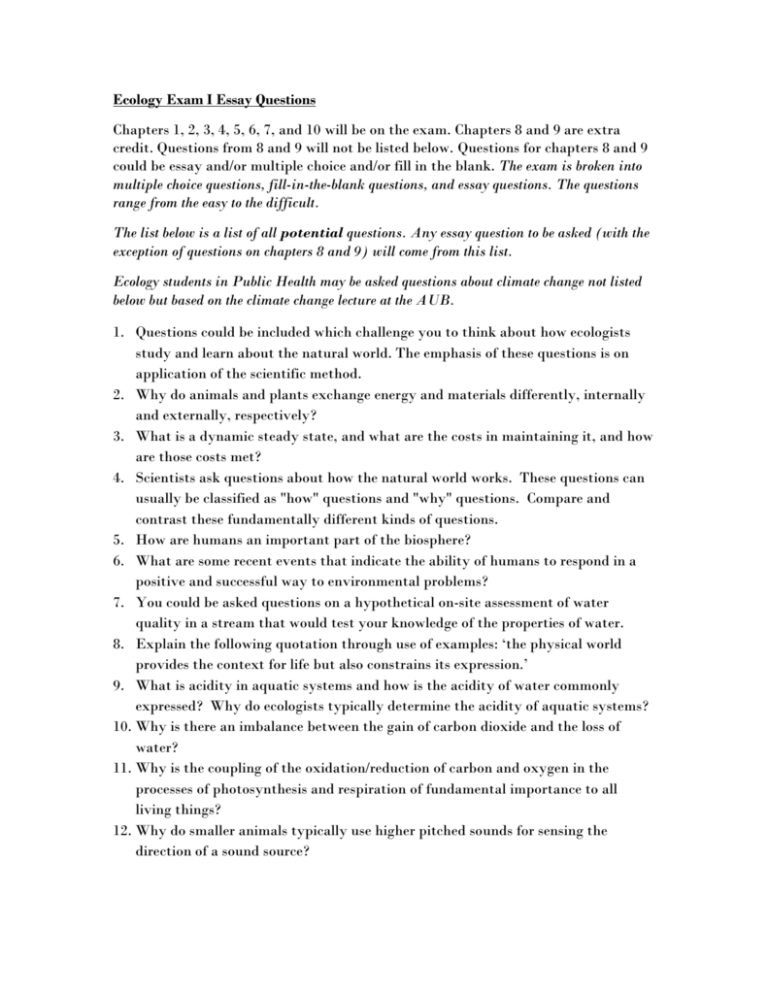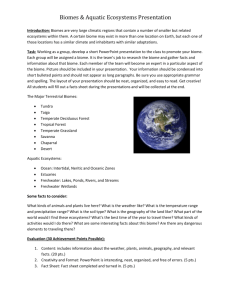Ecology Exam I Essay Questions
advertisement

Ecology Exam I Essay Questions Chapters 1, 2, 3, 4, 5, 6, 7, and 10 will be on the exam. Chapters 8 and 9 are extra credit. Questions from 8 and 9 will not be listed below. Questions for chapters 8 and 9 could be essay and/or multiple choice and/or fill in the blank. The exam is broken into multiple choice questions, fill-in-the-blank questions, and essay questions. The questions range from the easy to the difficult. The list below is a list of all potential questions. Any essay question to be asked (with the exception of questions on chapters 8 and 9) will come from this list. Ecology students in Public Health may be asked questions about climate change not listed below but based on the climate change lecture at the AUB. 1. Questions could be included which challenge you to think about how ecologists study and learn about the natural world. The emphasis of these questions is on application of the scientific method. 2. Why do animals and plants exchange energy and materials differently, internally and externally, respectively? 3. What is a dynamic steady state, and what are the costs in maintaining it, and how are those costs met? 4. Scientists ask questions about how the natural world works. These questions can usually be classified as "how" questions and "why" questions. Compare and contrast these fundamentally different kinds of questions. 5. How are humans an important part of the biosphere? 6. What are some recent events that indicate the ability of humans to respond in a positive and successful way to environmental problems? 7. You could be asked questions on a hypothetical on-site assessment of water quality in a stream that would test your knowledge of the properties of water. 8. Explain the following quotation through use of examples: ‘the physical world provides the context for life but also constrains its expression.’ 9. What is acidity in aquatic systems and how is the acidity of water commonly expressed? Why do ecologists typically determine the acidity of aquatic systems? 10. Why is there an imbalance between the gain of carbon dioxide and the loss of water? 11. Why is the coupling of the oxidation/reduction of carbon and oxygen in the processes of photosynthesis and respiration of fundamental importance to all living things? 12. Why do smaller animals typically use higher pitched sounds for sensing the direction of a sound source? 2 13. You could be asked questions that would challenge you to put to work some of the things you have learned about adaptations of animals to their environments. So, understand the energy budgets of animals. 14. What conflicts arise when plants meet their dual needs of obtaining carbon dioxide from the atmosphere while conserving water? 15. Compare and contrast the challenges faced by fresh-water aquatic and terrestrial animals from the perspective of water balance. 16. What are the costs vs. benefits of homeostatic regulation of internal conditions? 17. Is there a general rule that governs the rate of flux of heat or materials between an organism's tissues and the external environment? If so, what is it? 18. Why is adaptation to the environment a compromise? 19. Based on your understanding of larger-scale patterns of climatic variation and their causes, imagine you are a regional climatologist, with special expertise in Western Hemisphere climates. You are, in a sense, a "climate forecaster," using your understanding of past and present climate to help others plan for the future. Review climatic variation enough to be able to answer questions about intertropical convergence, seasonal variation in climate, and El Niño. 20. Be able to explain this quotation: "The surface of the earth, its waters, and the atmosphere above it are a giant heat-transforming machine." 21. Explain why biological activity is severely limited in a thermally stratified temperate lake in mid-summer surface and deeper waters. 22. In the temperate zone of the Northern Hemisphere, south-facing slopes of mountains are warmer and drier than north-facing slopes at the same elevation; vegetation growing on these different slopes will reflect the difference in local climate. Why is this? 23. The physical changes associated with El Niño events can cause cascading biological events, leading to dramatic fluctuations worldwide in populations of plants and animals. Describe, in your own words, the ecological consequences of an El Niño for a particular part of the world. 24. When a mountain range is exposed to prevailing winds from a particular direction, the windward side of the range (the side facing the prevailing winds) receives more precipitation than the leeward side (the side facing away from the prevailing winds). Low-lying areas to the leeward side of the range also tend to be much drier than areas at similar elevation to the windward side of the range. Explain these phenomena in detail. 25. Discuss some reasons why community composition changes as one moves (1) up a mountain and (2) down the continental shelf into the abyssal depths of the ocean. 26. A very wealthy friend of yours has decided to construct a massive indoor "biome garden," containing representative ecosystems from many parts of the world. 3 Your friend is in the early planning stages of this venture and has hired you as an ecological consultant. Your task is to help solve the many problems associated with designing greenhouse-style modules with appropriate environmental conditions for each of the biomes. The biome garden is to be developed where warm summers alternate with mild winters to create conditions naturally suitable for the temperate deciduous forest biome. The site chosen for development of the biome garden is a pine plantation that was established approximately 70 years ago. The soils are clayey, acidic, relatively infertile, and have low organic matter content. You are free to make any recommendations for environmental conditions in the greenhouse modules, regardless of the expense associated with implementing them. Also, you don't need to worry about how to implement these conditions. You would need to use your knowledge of biomes (and not just temperate biomes) to work to answer the questions. 27. The tropical rain forest is a diverse community supported by a nutrient-poor soil. Why? 28. The biome concept emphasizes the relationships among various growth-forms of plants and their physical environments. However, two other important factors influence the distributions of species. What are these? Provide a brief example of why each of these additional factors must be taken into account. 29. Why do desert trees have small, finely divided leaves, while leaves on trees in deciduous forests are broad? 30. In Whittaker's diagram relating distribution of the world's biomes to climate (Figure 5.11), most locations fall within a triangular area. Lacking are many places that experience cold temperatures combined with high precipitation. Why? 31. Why are deserts more likely to be found at around 30 degrees latitude than at other latitudes? 32. Why are the forms of plants more responsive to variations in climate than the forms of animals? 33. Understand the equations for photosynthesis. Example: what is the equation for net primary productivity? For gross primary productivity? 34. Understand secondary production. How do you determine ingestion and assimilation? Assimilation efficiency? Net production efficiency? Ecological efficiency? 35. Why is energy sometimes referred to as the "ecological currency" of an ecosystem? 36. Water is a reactant in the photosynthetic process. However, techniques for measuring net production focus on the other reactants and products of photosynthesis, to the exclusion of water. Why is this? 37. Does light limit photosynthesis? 38. Why is ecological efficiency not the same as gross production efficiency? 4 39. Understand global cycling of carbon and its relevance to the issue of global warming. 40. From a thermodynamic perspective, evaporation and condensation of water resemble photosynthesis and respiration. Please explain. 41. The water cycle can be viewed as an enormous solar-powered pump, transporting water from earth's oceans to its landmasses, whence the surplus water returns to the oceans via rivers. Please outline the details of this process. 42. Compare and contrast the paired processes of precipitation/dissolution and assimilation/dissimilation of carbon in aquatic systems. 43. The symbiosomes of root nodules harboring Rhizobium bacteria contain a special form of hemoglobin called leghemoglobin. What is the significance of leghemoglobin for nitrogen fixation in these root nodules? 44. Microorganisms figure prominently in global cycles of many elements. Discuss the significance of microorganisms in a particular elemental cycle, using specific examples. 45. In a mark-recapture exercise during which a population of butterflies remained constant in size, an initial sample provided 70 individuals, each of which was marked and then released back into the population. Two days later, a second sample was taken, totaling 321 individuals of which 74 bore a mark from the first sample. Estimate the size of the population. State any assumptions that you have had to make in arriving at your estimate. 46. Understand the continuum of ‘slow’ and ‘fast’. In other words, if you were to catalog the traits for different species, including development rate, age at sexual maturity, allocation of resources to reproduction, adult mortality rate, and length of life, and then you were to find these traits will not vary independently of one another but will instead exhibit correlated changes along a continuum, where would you place the traits along that continuum? Also, what is the relationship between sexual maturity and lifespan? What is the relationship between fecundity and adult mortality? 47. Understand consequences of litter supplementation (i.e. adding eggs to a nest). 48. What are some trade-offs in life history traits? 49. Given a fixed allocation of resources to reproduction, there are still many possible trade-offs between the size and number of offspring produced. What are those trade-offs? 50. How can reciprocal transplant experiments help us separate genetic and environmental contributions to phenotypic variation? 51. Is senescence inevitable? Please explain your answer, accounting for the great variation in patterns of aging among different species.








